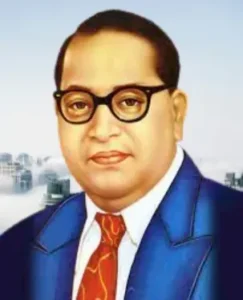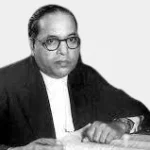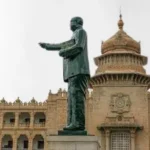Ambedkar Jayanti is observed annually on 14th April in India to commemorate the memory of B. R. Ambedkar. He was an Indian politician and social reformer. Ambedkar Jayanti is celebrated as a tribute to Ambedkar’s birthday who was born on 14 April 1891.His birthday is also referred to as ‘Equality Day’ by some in India. This day is also referred as Bhim Jayanti. This year in 2023, we will celebrate the 132nd Ambedkar Jayanti.
On this day senior national figures, such as the President, Prime Minister and leaders of major political parties, to pay homage at the statue of Ambedkar at the Parliament of India in New Delhi.
Ambedkar Jayanti

Ambedkar Jayanti is a public holiday in more than 25 states and union territories of India, including Andhra Pradesh, Bihar, Chandigarh, Chhattisgarh, Goa, Gujarat, Haryana, Himachal Pradesh, Jammu and Kashmir, Jharkhand, Karnataka, Kerala, Ladakh, Madhya Pradesh, Maharashtra, Odisha, Pondicherry, Punjab, Rajasthan, Sikkim, Tamil Nadu, Telangana, Uttarakhand, Uttar Pradesh and West Bengal etc.
B. R. Ambedkar’s first birthday was publicly celebrated on 14 April 1928 in Pune, by Janardan Sadashiv Ranapisay, who was an Ambedkarite and social activist. He started the tradition of Babasaheb’s birth anniversary or Ambedkar Jayanti.
B. R. Ambedkar
Bhimrao Ramji Ambedkar popularly known as B. R. Ambedkar ( Nickname – Babasaheb ) was a social reformer, lawyer and political activist. In 1947 Ambedkar became the law minister of the government of India. He took a leading part in the framing of the Indian constitution, outlawing discrimination against untouchables, and skillfully helped to steer it through the assembly. He resigned in 1951, disappointed at his lack of influence in the government.
B. R. Ambedkar is remembered for his contributions in drafting the Indian Constitution and for standing up for the rights of Dalits and the downtrodden. Dr Bhimrao Ambedkar is known as the father of Indian constitution. In 1990, the Bharat Ratna, India’s highest civilian award, was posthumously conferred on Ambedkar.
In October 1956, in despair because of the perpetuation of untouchability in Hindu doctrine, B. R. Ambedkar renounced Hinduism and became a Buddhist, together with about 200,000 fellow Dalits, at a ceremony in Nagpur. Ambedkar’s book The Buddha and His Dhamma appeared posthumously in 1957, and it was republished as The Buddha and His Dhamma: A Critical Edition in 2011.
Family & Early Life
Date of Birth – 14 April 1891
Place of Birth – Mhow, Central India Agency, British India, (now Dr Ambedkar Nagar,Madhya Pradesh, India)
Date of Death – 6 December 1956 ( age 65 )
Place of Death – New Delhi, India
Parents – He was the 14th and last child of Ramji Maloji Sakpal, an army officer who held the rank of Subedar in British Indian Army at the Mhow cantonment, and Bhimabai Sakpal, daughter of Laxman Murbadkar.
His family was of Marathi background from the town of Ambadawe (Mandangad taluka) in Ratnagiri district of modern-day Maharashtra.
Marriage – Ambedkar’s first wife was Ramabai. She died in 1935 after a long illness. After completing the draft of India’s constitution in the late 1940s, Ambedkar suffered from lack of sleep, had neuropathic pain in his legs, and was taking insulin and homoeopathic medicines. He went to Bombay for treatment, and there met Sharada Kabir, whom he married on 15 April 1948, at his home in New Delhi. Doctors recommended a companion who was a good cook and had medical knowledge to care for him. She adopted the name Savita Ambedkar and cared for him the rest of his life. Savita Ambedkar, who was called also ‘Mai’, died on May 29, 2003, aged 93 in Mumbai.
Son – Yashwant Ambedkar (known as Bhaiyasaheb Ambedkar), died in 1977.
Education
Matriculation/10th – Elphinstone High School, Bombay/Mumbai in 1907.
Intermediate – Elphinstone College, University of Bombay/Mumbai .
Graduation Degree ( Economics and Political Science ) – University of Bombay/Mumbai, 1912.
Master of Arts ( June 1915 ) – Columbia University, New York ( In 1913, at the age of 22, Ambedkar was awarded a Baroda State Scholarship of £11.50 (Sterling) per month for three years under a scheme established by Sayajirao Gaekwad III (Gaekwad of Baroda) that was designed to provide opportunities for postgraduate education at Columbia University in New York City.

Bar course at Gray’s Inn, London School of Economics, University of London – 1916-1923 ( Doctorate & advocate )
Fight against Untouchability
B. R. Ambedkar was born into a Mahar (dalit) caste, who were treated as untouchables and subjected to socio-economic discrimination. Ambedkar’s ancestors had long worked for the army of the British East India Company, and his father served in the British Indian Army at the Mhow cantonment. Although they attended school, Ambedkar and other untouchable children were segregated and given little attention or help by teachers. They were not allowed to sit inside the class.
When they needed to drink water, someone from a higher caste had to pour that water from a height as they were not allowed to touch either the water or the vessel that contained it. This task was usually performed for the young Ambedkar by the school peon, and if the peon was not available then he had to go without water, he described the situation later in his writings as “No peon, No Water”. He was required to sit on a gunny sack which he had to take home with him.
As Ambedkar was educated by the Princely State of Baroda, he was bound to serve it. He was appointed Military Secretary to the Gaikwad but had to quit in a short time, but again ill-treated by his high-caste colleagues, he turned to legal practice and to teaching. He soon established his leadership among Dalits, founded several journals on their behalf, and succeeded in obtaining special representation for them in the legislative councils of the government.
He also tried to find ways to make a living for his growing family. He worked as a private tutor, as an accountant, and established an investment consulting business, but it failed when his clients learned that he was an untouchable. In 1918, he became Professor of Political Economy in the Sydenham College of Commerce and Economics in Mumbai. Although he was successful with the students, other professors objected to his sharing a drinking-water jug with them.
B. R. Ambedkar fought for the rights of the downtrodden and played a major role in mobilizing them. It was because of him that many people belonging to the ‘lower caste’ began demanding their rights. He always tried to ensure that the historically unprivileged sections of the country got representation at various institutions. He also worked for their education as well as economic development. Ambedkar, by the means of journals such as Bahishkrit Bharat (literally, Ostracized India), Equality Janta, and Mooknayak (Leader of the Dumb), advanced the betterment of the lives of Dalits. He also founded the Bahishkrit Hitakarini Sabha which advocated for the development of Dalits.
Ambedkar led a movement against untouchability in 1927. Here, he criticised Hindu religious texts for their propagation of untouchability. He worked to ensure the ‘untouchables’ were allowed to enter religious places as well as draw water from public wells. He also led many Dalits to burn copies of Manusmriti, which justifies caste-based discrimination and untouchability, on 25 December 1927. Besides all these, Ambedkar signed the Poona Pact with Mahatma Gandhi in 1932, facilitating the reservation of seats for Dalits (then known as Depressed Classes). Earlier in 1930, he had led around 15000 Dalits to enter the Kalaram Temple to help them see God for the first time.
While B. R. Ambedkar saw the caste issue as a political problem, Gandhi considered it a social issue. Ambedkar sought political solutions to the problem, while on the other hand, Gandhi believed it could be solved only if the minds of people were changed. Ambedkar wished to abolish the caste system altogether since he believed that it could just not be modified since it was too deeply ingrained in society. Gandhi however, tried to bring about change in the mindset of the people instead. These led to several clashes between the two. But a consensus was reached with the Poona Pact that sought to provide representation for the Dalits in civil services, while also providing them with educational grants.
Father of India’s Constitution
Upon India’s independence on 15 August 1947, the new prime minister Jawaharlal Nehru invited B. R. Ambedkar to serve as the Dominion of India’s Law Minister; two weeks later, he was appointed Chairman of the Drafting Committee of the Constitution for the future Republic of India.
The Constitution was adopted on 26 November 1949 by the Constituent Assembly.

Indian constitution guarantees and protections for a wide range of civil liberties for individual citizens, including freedom of religion, the abolition of untouchability, and the outlawing of all forms of discrimination. Ambedkar was one of the ministers who argued for extensive economic and social rights for women, and won the Assembly’s support for introducing a system of reservations of jobs in the civil services, schools and colleges for members of scheduled castes and scheduled tribes and Other Backward Class, a system akin to affirmative action. India’s lawmakers hoped to eradicate the socio-economic inequalities and lack of opportunities for India’s depressed classes through these measures.
Important Facts to know about Dr B. R. Ambedkar
1 – He was free India’s first law minister.
2 – The Maharashtra government has acquired a house in London where Ambedkar lived during his days as a student in the 1920s. The house is expected to be converted into a museum-cum-memorial to Ambedkar.
3 – Ambedkar was voted “the Greatest Indian” since independence by a poll organised by History TV18 and CNN IBN, ahead of Patel and Nehru, in 2012. Nearly 20 million votes were cast.
4 – On 2 April 1967, an 3.66 metre (12 foot) tall bronze statue of Ambedkar was installed in the Parliament of India. The statue, sculpted by B.V. Wagh, was unveiled by the then President of India, Sarvepalli Radhakrishnan.
5 – On 12 April 1990, a portrait of B.R. Ambedkar is put in the Central Hall of Parliament House.
6 – Jai Bhim slogan was given by the Dalit community in Delhi in his honour in 1946.
7 – Google commemorated Ambedkar’s 124th birthday through a homepage doodle on 14 April 2015. The doodle was featured in India, Argentina, Chile, Ireland, Peru, Poland, Sweden and the United Kingdom.
8 – Chaitya Bhoomi ( Dr. Babasaheb Ambedkar Mahaparinirvan Memorial) is a Buddhist chaitya and the cremation place of B. R. Ambedkar, the chief architect of the Indian Constitution. It is situated besides Dadar Chowpatty (beach), Mumbai. Chaitya Bhoomi is a revered place of pilgrimage for Ambedkar’s followers, who visit in millions annually on his death anniversary (Mahaparinirvan Diwas) on 6 December. Chaitya Bhoomi hosts a memorial to Ambedkar and has been graded an A-class tourism and pilgrimage site by the Government of Maharashtra.
9 – Deekshabhoomi is a sacred monument of Navayana Buddhism located at Nagpur city in Maharashtra state of India, where Dr. B. R. Ambedkar, embraced Buddhism with approximately 600,000 of his followers mainly scheduled caste peoples on Ashoka Vijaya Dashami on 14 October 1956. Ambedkar revived Buddhism in India. Ambedkar’s conversion to Buddhism is deeply significant for millions of people in India. According to the 2011 India census, more than 87% of the total Buddhist population in India are Ambedkarite Buddhists.
10 – Statue of Equality ( Ambedkar ) – The Statue of Equality also known as the Dr. Babasaheb Ambedkar Memorial is an under-construction monument dedicated to B. R. Ambedkar, the 20th-century Indian intellectual and the father of the Indian Constitution. The statue will be located at Indu Mills Compound in Mumbai in the state of Maharashtra. The statue of Babasaheb Ambedkar will be 137.3-metre (450 ft) in total height, including a 30.5-metre (100 ft) pedestal. The Ambedkar statue will be the third tallest statue in the world after the Statue of Unity (182 m) and the Spring Temple Buddha (153 m).

The foundation stone was laid on 11 October 2015 by Prime Minister Narendra Modi.
11 – Dr. Babasaheb Ambedkar’s real surname was Ambawadekar. But his teacher, Mahadev Ambedkar, gave him Ambedkar’s surname in the school records.
12 – Dr. Babasaheb Ambedkar was the first Indian to get a Doctorate (Ph.D.) degree in Economics from abroad.
13 – B. R. Ambedkar is the only Indian whose statue is attached to Karl Marx in the London Museum.
14 – The credit of giving place to “Ashok Chakra” in the Indian Tricolour also goes to Dr. Babasaheb Ambedkar. Although the National flag was designed by Pingali Venkayya.
15 – The book “Waiting for a visa” written by B. R. Ambedkar is a textbook at Columbia University. Columbia University made a list of the world’s top 100 scholars in 2004 and the first name on that list was Dr. Bhimrao Ambedkar.
16 – Dr. Babasaheb Ambedkar was a master in 64 subjects. He had knowledge of 11 languages like Hindi, Pali, Sanskrit, English, French, German, Marathi, Persian, and Gujarati. Apart from this, he studied all the religions of the world in a comparative way for almost 21 years.
17 – In the London School of Economics, Babasaheb completed 8 years of studies in just 2 years 3 months. For this, he studied 21 hours a day.
18 – Babasaheb is the first and only person in the world to receive a valuable doctorate degree named “Doctor All Science” from the London School of Economics. Many intelligent students have tried for it, but they have not been successful until now.
19 – In 1954, in the “World Buddhist Council” held in Kathmandu, Nepal, Buddhist monks had given B. R. Ambedkar the highest title of Buddhism “Bodhisattva”. His famous book “The Buddha and his Dhamma” is the “scripture” of Indian Buddhists.
20 – As the member for labour in the viceroy’s council from 1942 to 1946, B. R. Ambedkar was instrumental in bringing about several labour reforms. He changed the working hours from 12 hours to 8 hours in the 7th session of Indian Labour Conference in New Delhi in November 1942. He also introduced several measures for workers like dearness allowance, leave benefit, employee insurance, medical leave, equal pay for equal work, minimum wages and periodic revision of scale of pay. He also strengthened trade unions and established employment exchanges across India.
21 – RBI was conceptualized on 1st April 1935 by the guidelines from Babasaheb Ambedkar’s book “Problem of Rupee: its origin and its solutions”
1 thought on “Ambedkar Jayanti, Who was Dr B. R. Ambedkar? Most Important Facts”